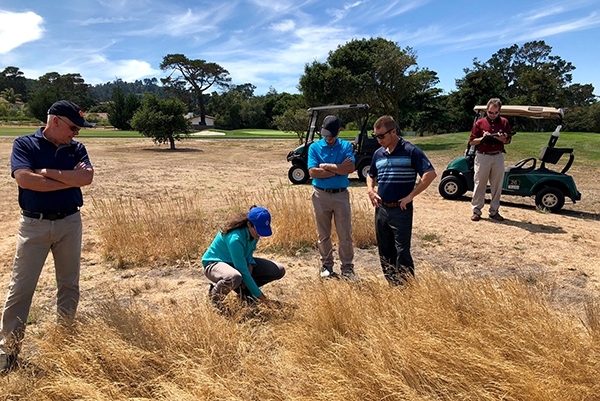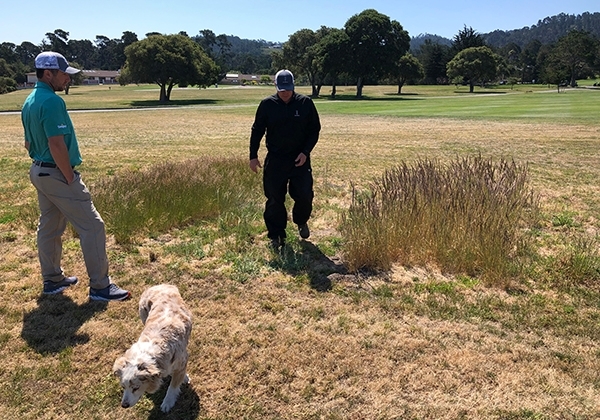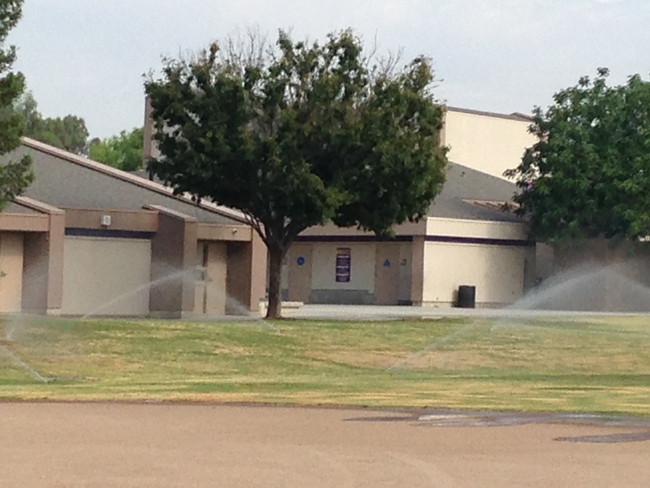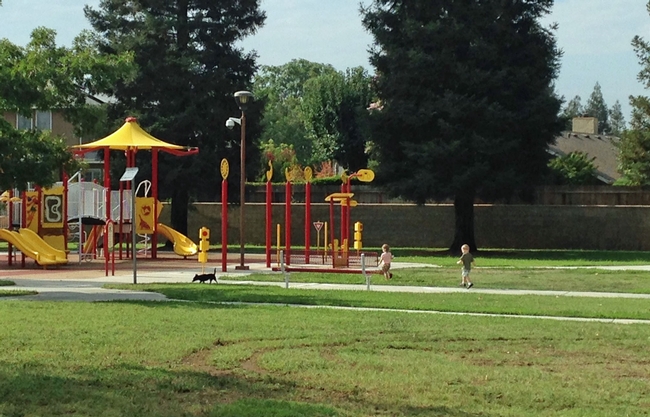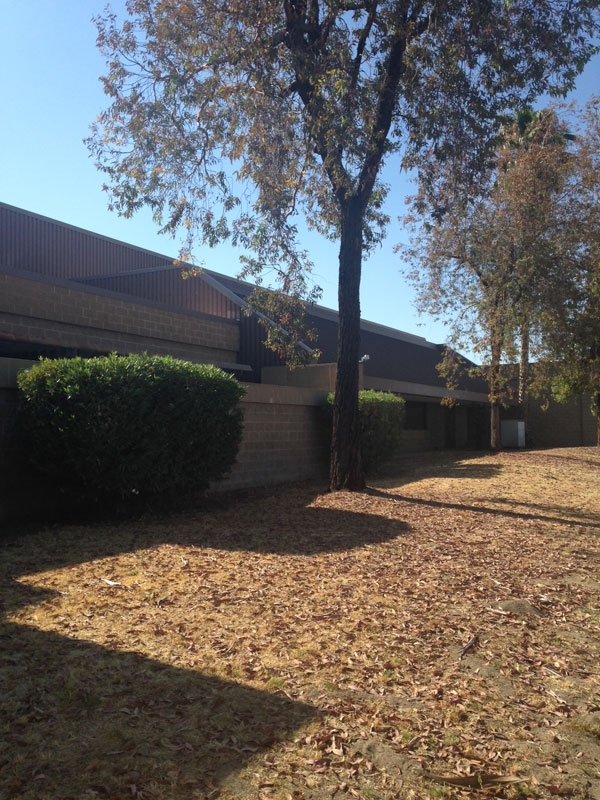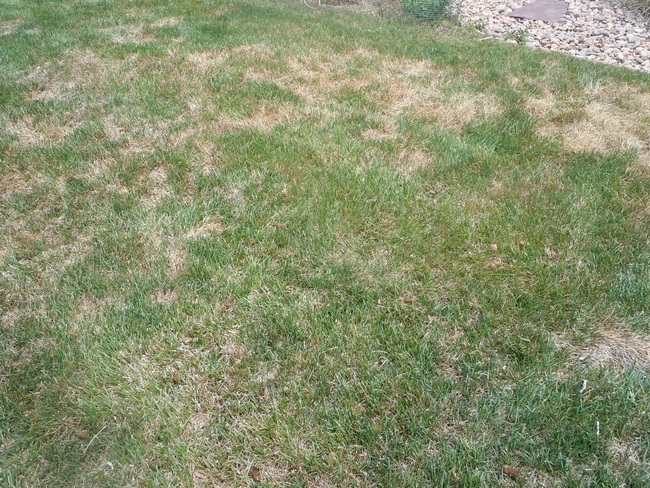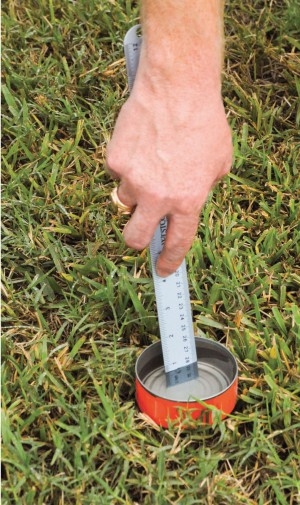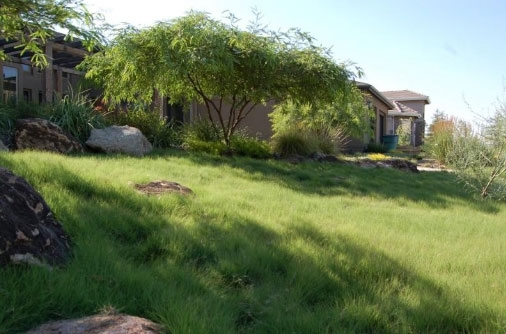Posts Tagged: Turfgrass
UC Cooperative Extension studies organic herbicides for weed control in landscapes
The safety of the weed killer glyphosate, the active ingredient in some well-known Roundup products, has been the subject of attention recently because of lawsuits that connected the chemical to cancer in humans.
Based on extensive scientific research, U.S. regulatory agencies have not banned glyphosate, but the publicity has increased interest in alternatives to the herbicide, which is the most widely used pesticide in the world.
“Everybody is really clamoring for information,” said area integrated pest management advisor Karey Windbiel-Rojas. “Efficacy of organic herbicides is one of the most popular talks I am giving at the moment.”
Windbiel-Rojas and former UC Cooperative Extension environmental horticulture advisor Maggie Reiter launched research projects in 2019 to help fill knowledge gaps on the effectiveness of organic herbicides in urban landscapes – such as lawns, golf courses, parks, cemeteries and school grounds. (Reiter has since taken an extension educator position at the University of Minnesota.)
Organic herbicides are pesticides made of compounds that occur in nature; and synthetic herbicides are compounds developed in laboratories. While both can be more toxic or less toxic to people and the environment, some people prefer using organic methods or chemicals.
On a small scale, a variety of organic solutions to weeds are readily available – such as hand pulling, hoeing and mulching. For larger jobs, professional landscape managers prefer applying an herbicide and look to UC Cooperative Extension scientists to know how well different options will work.
Reiter set up a study on at Ridge Creek Golf Course in Dinuba, and Windbiel-Rojas set up a study on a landscaped area with a mix of grasses and weeds in a parking lot at Sacramento State University.
In the Dinuba experiment, Reiter applied organic herbicides on 25-square-foot plots in four replications. The active ingredients of the organic herbicides included such naturally occurring chemicals as citric acid, clove oil, orange oil, acetic acid (vinegar four times stronger than that found in most home pantries), soaps, and caprylic acid, which comes from coconut and palm kernel oils.
The plots treated with citric acid and clove oil remained as green and lush as the grass in the control areas, which hadn't been treated at all. The areas sprayed with the other organic herbicides showed significant injury two days after treatment. However, 19 days post-treatment the plots treated with caprylic acid and herbicide soaps had completely recovered. The plots treated with orange oil and acetic acid recovered after 28 days.
In the Sacramento State trial, Windbiel-Rojas used some of the same organic compounds, plus others with different natural ingredients, such cinnamon oil, pelargonic acid and ammonium nonanoate, which are drawn from fruit, vegetables and other plant sources.
Many products burned down both grasses and broad-leaf weeds after a few days, however, a couple weeks later, the weeds began to regrow or recover. In addition, some of the organic treatments are more acutely toxic to people than glyphosate.
“While organic, 20% acetic acid is very toxic to the person applying the herbicide,” Windbiel-Rojas said. “It will burn one's skin, hair and eyes so the applicator must wear more personal protective equipment than with some other herbicides. This material is also problematic to use in a public space because any bystanders could be exposed to drift during application.”
The research was published in the February 2020 issue of CAPCA Adviser Magazine. The findings of the research on organic herbicides for turfgrass are preliminary and UC IPM researchers will continue to investigate options.
Windbiel-Rojas will present “Glyphosate Alternatives and Organic Herbicides in Landscapes: Efficacy and Tradeoffs” at the Pesticide Applicators Professional Association Zoom webinar Dec. 2. View the agenda here: https://www.papaseminars.com/uploads/Seminars/11643.pdf. For more information and the registration link, visit https://www.papaseminars.com/seminars.
Golf courses go wild
When we think about golf courses, we tend to picture miles of well-watered, uniformly clipped, and perfectly manicured grass, not drought-tolerant native grass, wildlife habitat and ecological restoration. However, for Maggie Reiter, a UC Cooperative Extension turfgrass and environmental horticulture advisor based in Fresno County, this is par for the course.
“I've always worked in the turfgrass and golf course management domain,” said Reiter. “Since I began 12 years ago, the proportion of naturalized areas on golf courses has increased. Now native grass stands and wildlife habitat are projected to make up 26% of golf course facilities. From a research and extension perspective, there is little information on management of these natural areas. So, there is a need for expertise on managing golf course naturalized areas for multiple functions, including ecological restoration goals.”
Reiter works with golf course superintendents, who she says are professional stewards of the land. Superintendents seek new methods of maintenance that require less water, fertilizer and labor and promote landscapes that support biological diversity and conservation, in addition to providing a high-quality arena for golf. Golf courses have the potential to provide ecosystem services and community-wide ecological benefits, such as capturing stormwater runoff, providing wildlife habitat, sequestering carbon and relieving urban heat island effects.
One approach Reiter takes to meet these goals is to reduce the amount of maintained turf by converting the less frequently played areas of golf courses to native grasslands. Determining the ideal varieties of grasses to plant can be challenging since there are more than 250 grasses native to California. Native grass seeds are more expensive and less readily available than traditional turfgrasses, which limits the options for use in restoring native grasslands in landscapes. Reiter and her team were able to test only 13 native grasses in their field trials. In addition, the establishment period for native perennial grasses can be two to five years, in contrast to traditional turf varieties that take a few months.
“That is a surprising challenge I didn't anticipate,” Reiter explained. “Golf course superintendents have expectations for naturalized area establishment that do not align with reality because these California native grasses are so different from conventional turfgrasses. I've spent a tremendous amount of time communicating with golf course superintendents, managers, golfers, and other stakeholders to establish realistic expectations.”
Once the experimental grasses are established, Reiter, a golfer herself, has to determine the playability of each variety. Playability of a grass has to do with a player's ability to find the golf ball and advance the ball through the grass and is an important factor in designing naturalized areas. Poor playability on a course can slow down the pace of play, which detracts from the golfer's experience. Measuring stand height, plant density and aboveground biomass indicate visual obstruction, but does this determine playability?
“Measuring playability is an enigma that I think about often, and have no good answer for at this point. There is no consensus in the turfgrass research world on how to measure these complex habitats,” Reiter said. “Engaging in the golf course landscape by playing helps me feel things from the golfer's perspective.”
When Reiter is not on the golf course or working on field trials, she advises schools, parks and recreational sports fields and provides education on general turfgrass management for her local Master Gardener programs as part of her extension work. It turns out that parks and schools are facing major challenges similar to those on golf courses – they need to conserve water and absorb rising labor costs. Reiter says that golf courses may have more resources to respond to these problems, but the tradeoff is that they have higher expectations for aesthetics and performance from native grasses.
Reiter is relatively early in her career, but no doubt she will continue to work with her partners on golf courses and beyond to solve grand problems and incorporate native grasslands within traditional turf areas. It is clear that she is passionate about improving land management practices to protect California's natural resources and promote community health and wellness.
“It is important to me to increase the ecological sustainability of golf courses, and more widely, urban landscapes,” Reiter said.
This article was first published with more photos in The Confluence, the California Institute for Water Resources blog.
Drought concerns causing unnecessary impact on landscapes and lawns
“Landscape plants and the water they use are under unrelenting attack,” says Don Hodel, UC ANR Cooperative Extension advisor in Los Angeles County. “But most of these attacks are misguided when one looks at the facts.”
Hodel and Dennis Pittenger, UC ANR Cooperative Extension area environmental horticulturist in the Department of Botany and Plant Sciences at UC Riverside, wrote a six-page commentary, 9%: The California Drought and Landscape Water Use, with facts about the relatively small amount of California's water that goes into landscapes, and the tremendous benefits to residents, communities and the environment provided by these plants. The article was published in PalmArbor, an electronic journal for the green industry.
“Landscape water use in California accounts for only 9 percent of total statewide water use,” the authors wrote. “Yes, that's right, just 9 percent. If we never watered another home or public landscape, park, sports field, or golf course in California, the state would save 9 percent of its total water consumption.”
Pittenger and Hodel named 12 ways lawns and landscape plants enhance the quality of Californians' lives and make urban areas more livable. Trees, shrubs, groundcovers, lawns and flowers provide:
- Oxygen
- Carbon sequestration to help mitigate global warming
- Rain capture, dust and erosion control
- Shade and energy savings in heating and cooling
- Wildlife habitat
- Food
- Beauty and ornament
- Recreation
- Enhanced property values
- Psychological well-being
- Cultural/historic value
- Jobs and economic value
The authors assert that California cannot conserve its way out of drought by trying to wring out significant water savings from the 9 percent that keeps landscapes alive.
Instead of shutting off the sprinklers, the authors call for “judicious irrigation,” providing just enough water to trees, plants and lawns to keep them alive. The authors believe judicious irrigation may be sufficient by itself to meet the 25 to 35 percent water reductions required by the state without changing the landscape to so-called “low-water use” or “drought-tolerant” plants.
“Most woody plants are actually drought-tolerant and low-water use once they are established and cared for properly,” the article says. “Research over the last 30 years has shown that water-reduction goals can be met while maintaining the quality-of-life benefits that landscape plants and functional lawns provide.”
Hodel and Pittenger also identified three urban water uses that should be considered priorities for outdoor irrigation, even in times of extreme water scarcity.
- Public parks, school play grounds and sports fields. “Children need to play and exercise on grass, not asphalt or dirt,” the article says. “And we all benefit from walking and exercising in a green, pastoral setting.”
- Bona fide botanical gardens and arboreta. “These research collections of plants have immense value,” the authors wrote. “For example, the plant collections at the world-famous San Diego Zoo actually have greater value than the animals.”
- Trees. “Mature trees are among the most valuable and difficult-to-replace plants in urban areas,” the UC ANR experts said. “Their loss would be devastating.
The director of UC ANR's California Institute for Water Resources, Doug Parker, is a spokesperson for the University of California on water issues of statewide importance. He agrees that, in much of the state, urban communities benefit from natural plantings and turf should be a priority for recreation areas.
“It's true that rock gardens, artificial turf and hardscape do not provide much wildlife habitat, carbon sequestration or environmental cooling,” he said. “But in places like Palm Springs, they are appropriate.”
Having worked closely with policymakers, scientists, government organizations and consumers during the past four years of drought, Parker said he has reached the conclusion that Californians cannot build or conserve their way out of periodic droughts.
“What we really need is a change in mindset to learn to live with drought and uncertainty,” Parker said.
Following are free water-conservation publications from UC ANR:
Water conservation tips for the home lawn and garden
By Pamela Geisel, UC ANR Cooperative Extension advisor emeritus
Carolyn Unruh, staff writer
Managing turfgrasses during drought
By Ali Harvandi, UC ANR Cooperative Extension advisor emeritus
Jaimes Baird, UC ANR Cooperative Extension turfgrass specialist, UC Riverside
Janet Hartin, UC ANR Cooperative Extension environmental horticulture advisor, San Bernardino County
The drought needs not be a death sentence for lawns
While a golden brown lawn is seen as a badge of honor to some residents of drought-stricken California, in fact, they are doing more harm to the environment than good, says UC Agriculture and Natural Resources turf expert Jim Baird.
“People have gone from one extreme to another,” said Baird, UC ANR Cooperative Extension turf specialist based at UC Riverside. “When we weren't in a water crisis, people were watering seven days a week, 365 days a year. Now, people feel like they're doing the right thing by putting no water on their lawn at all.”
Baird developed a keen appreciation for turf as a teenager playing golf and later working at a municipal golf course in Pueblo, Colo. “I found my passion,” he said. “The rest is history.” He earned a bachelor's degree in horticulture, a master's degree in agronomy, and a doctorate in botany, all the while focused on turf.
Baird's research and the lawn in front of his own Riverside home show that turf can be kept alive, and even attractive, with a minimal amount of water. And maintaining lawns rather than letting them die or replacing the grass with synthetic turf, concrete or so-called drought-tolerant plants offers important ecological services.
As anyone who has enjoyed a picnic in the park can attest, grass is cool. In contrast, the surface of artificial turf has been found to reach 180 degrees on a hot day. It often must be cooled with water before it can be used for sports. Bare soil, concrete and asphalt get significantly warmer and hold heat longer than a grassy lawn, which functions like a natural evaporative cooler.
“The more we let our grass lawns die or go away, the hotter it's going to get,” Baird said.
Grass, like all plants, absorbs carbon from the atmosphere and sequesters it in the soil, a vitally important quality as the country searches for ways to slow global warming. The production of plastics to make artificial turf has the opposite impact. And after a decade or so, artificial turf will wind up in the landfill, where it could take hundreds of years to decompose.
Grass provides food and habitat for birds and small mammals, with the abundant insects, spiders and worms living among the blades and below the surface. Unlike concrete, asphalt and hard-packed earth, properly maintained turfgrass is porous, allowing water to infiltrate when it does rain, rather than sheeting off the surface and into storm drains. Soil erosion and dust are also reduced or eliminated with grass lawns.
With all these benefits, Baird is dismayed to see the abundance of unnecessarily dead and dying lawns in California. The loss of green growing grass is an ecological loss in the short term, and difficult and expensive to revive once the drought ends.
“A dead lawn could come back as nothing but weeds,” Baird said.
He and his UC ANR colleagues wrote an eight-page publication on managing turfgrass under drought conditions that will help homeowners and lawn managers keep their lawns alive with minimal water.
The publication outlines the concept of deficit irrigation, a system in which the grass has just enough water to maintain an adequate appearance, but with less growth. Irrigation can be cut back to two times per week. If the blades spring back after being walked on, the lawn doesn't need more water.
“The grass may not be as lush and green as usual, but you can still have a lawn where kids and pets can play and families can enjoy outdoor barbecues,” Baird said.
Additional water savings can be achieved by carefully managing the sprinkler system. Areas shaded by trees or a house need less water than grass with day-long sun exposure. Irrigating before dawn reduces evaporation, leaving more water for the plant roots to absorb. Using sprinklers when there is less wind will help prevent overspray onto sidewalks and the street.
“We suggest homeowners test their sprinklers by placing cans around the lawn and running the sprinklers to see if water is being applied uniformly,” Baird said. “This also provides the opportunity for them to see if there are any broken sprinklers or leaks that need to be repaired.”
Mowing practices also impact the lawn's water use. The grass should be maintained at the tallest height recommended for the species being grown to encourage development of deep roots. Leaving the grass clippings on the lawn with a mulching mower will reduce evaporation from the soil surface.
If new lawns are being considered, water use can be cut by selecting a turfgrass species that uses less water. For example, Baird is studying kikuyugrass in plots at UC Riverside Turfgrass Research Facility. A native of East Africa, kikuyugrass is well adapted to warm, temperate climates in coastal areas and inland valleys of Southern and Central California. Other drought-tolerant grasses being studied at the facility are Bermudagrass and seashore paspalum.
A pdf version of Managing turfgrasses during drought, which includes grass species recommendations, is available for free download from the UC ANR online publication catalog.
For professional landscapers and home gardeners interested in detailed turfgrass research information, UC ANR is hosting a Turfgrass and Landscape Research Field Day Sept. 17. Registration is $90 before Aug. 28, $100 on or after Aug. 28 and $120 onsite. The complete agenda, registration form and previous research reports can be found on the field day website.
An initiative to improve California water quality, quantity and security is part of the UC Division of Agriculture and Natural Resources Strategic Vision 2025.
Author: Jeannette Warnert
Green going out of fashion in California
Many Californians are beginning to reluctantly accept that a well-manicured, lush green lawn is no longer a realistic landscape feature in the arid West, reported Steven Kurutz in the New York Times.
Chuck Ingels, UC Cooperative Extension advisor in Sacramento County, told the reporter homeowners with traditional green lawns may soon have no choice but to let them go brown. An average of 50 to 60 percent of a household's water consumption goes to outdoor use, which includes the landscape. He envisions a future in which lawns go dormant in winter and in summer, if watering is not allowed.
“The water bills are going up,” Ingels said. “I think we're going to start seeing more and more people opt for a brown lawn. I think it could become more traditional.”
If some water is available, there are less thirsty alternatives to traditional lawns that can provide a similar effect. Ingels has experimented with meadow-like buffalograss and dune sedge as alternatives. For example, UC Verde buffalograss, released in 2003, was bred for the California climate by UC researchers. It needs only infrequent mowing, uses half the water of tall fescue and is disease and pest resistant.
Other options are drought-tolerant native species like carex and bentgrass. These can be used for the meadow effect if not mowed, or mowed regularly for a more traditional look.




